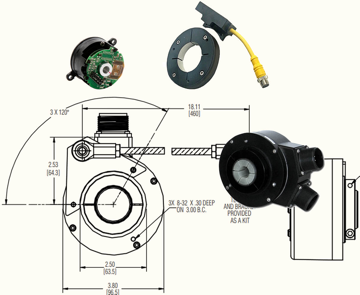When Should You Use a Coupling to Mount Encoders?
Posted by London Rhodes on Jan 19, 2022 7:44:44 AM
Couplings also allow the encoder to compensate for shaft misalignment. Cutouts on the coupling allow flex to occur in the coupling rather than in the motor shaft. The runout from the shaft is absorbed by the coupling to prevent physical damage to the encoder.
Topics: How to Choose An Encoder, Installation, Troubleshooting
What Are Indications of Good Encoder Output?
Posted by London Rhodes on Sep 29, 2021 1:41:32 PM
Topics: Installation, Encoder Signals Output, Troubleshooting
What Should I Consider When Installing an Encoder Tether?
Posted by London Rhodes on Aug 27, 2021 2:10:16 PM
Encoder tethers are designed and engineered to allow the encoder to float with the run-out of the motor shaft. If the tether is bolted too rigidly to the motor, then run-out from the motor can damage the encoder bearings. It is critical to use the parts provided with the encoder during installation to ensure the tether is properly placed. Avoid bending the tether from the position in which it is provided from the factory.
Topics: Installation, Troubleshooting
Why are Tethers Important for Encoders?
Posted by London Rhodes on Aug 27, 2021 2:01:41 PM
Without a functional tether, the wobble from the motor shaft will create additional wear on encoder bearings causing them to fail. Friction from bearing failure will cause encoder electronics to overheat.
Topics: Installation, Troubleshooting
What is an Encoder Tether?
Posted by London Rhodes on Aug 27, 2021 1:59:00 PM
A tether is an anti rotation device mounted between motor and encoder to ensure the encoder remains stationary while the motor is running.
Topics: Installation, Absolute Encoders, Troubleshooting
How Many Shaft Positions Exist on Absolute Encoders?
Posted by London Rhodes on Jul 29, 2021 10:33:47 AM
You can calculate the number of shaft positions on your encoder with the following equation: 2x where X = the resolution of your absolute encoder in bits.
Topics: Installation, Absolute Encoders, Encoder Signals Output, Troubleshooting
How to Calculate Frequency Response?
Posted by London Rhodes on Jul 29, 2021 10:30:48 AM
RPM x PPR / 60 = Frequency Response in Hertz
Topics: Troubleshooting
What Should I Consider When Converting DC Tachometers to Encoders?
Posted by London Rhodes on Jul 29, 2021 10:27:16 AM
Topics: Installation, Troubleshooting
What is the Maximum Length of Cable I Can Use on a Dynapar Encoder?
Posted by London Rhodes on May 24, 2021 2:46:50 PM
Many factors play a role in determining the maximum length of cable that can be used to connect the encoder to the controller. The largest problem with running long lengths of cable is that the cable becomes more susceptible to noise. This is due to the capacitance of the cable, the cable acting as an antenna, and the loss of power through the cable. The maximum distance of cable can be achieved by following some basic wiring principles. Do not run the cable near objects that create a lot of electrical noise. This includes AC motors, Arc welders, AC power lines, and transformers. Use twisted pair cabling when using the signal and its complement, and shielded cabling when running any type of signal. Use the highest voltage available for the output voltage. For example, if the encoder will output 5 to 24 volts, then use 24 volts. Use an Open Collector or Differential Line Driver output with a differential receiver (PM28S00) so that the maximum amount of current can be sink/sourced.
If you are using the encoder as an input to more than 1 controller, use a signal amplifier. This is also a good way to help increase the distance a signal can travel. Typical maximum distances for a Differential Line Driver are around 100 ft.or more when using a differential input, and for an Open Collector the distance is around 35 ft.
Topics: Installation, Encoder Signals Output, Troubleshooting
What is the Purpose of the A not and B not Channels?
Posted by London Rhodes on May 24, 2021 12:36:57 PM
The A not and B
Topics: Encoder Signals Output, Troubleshooting

